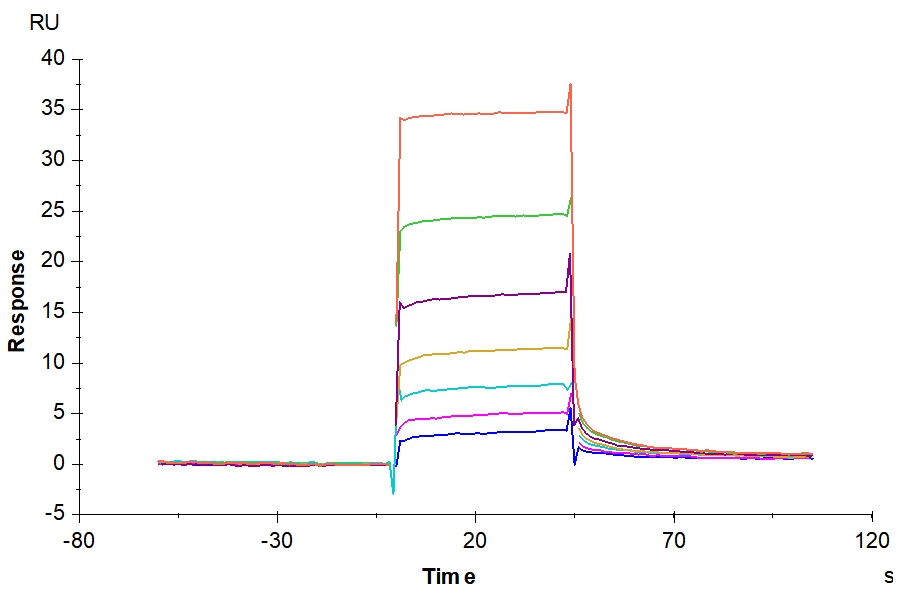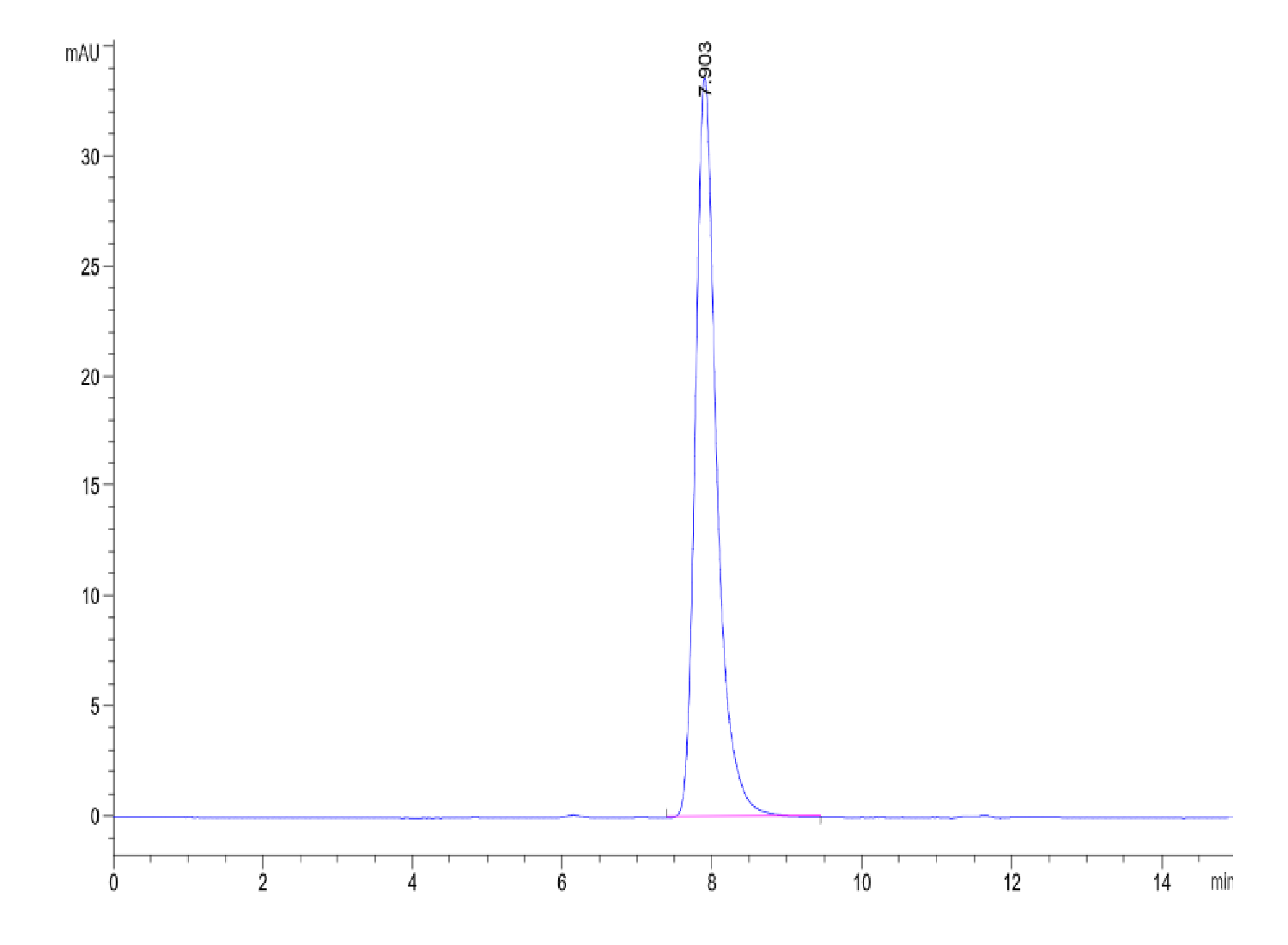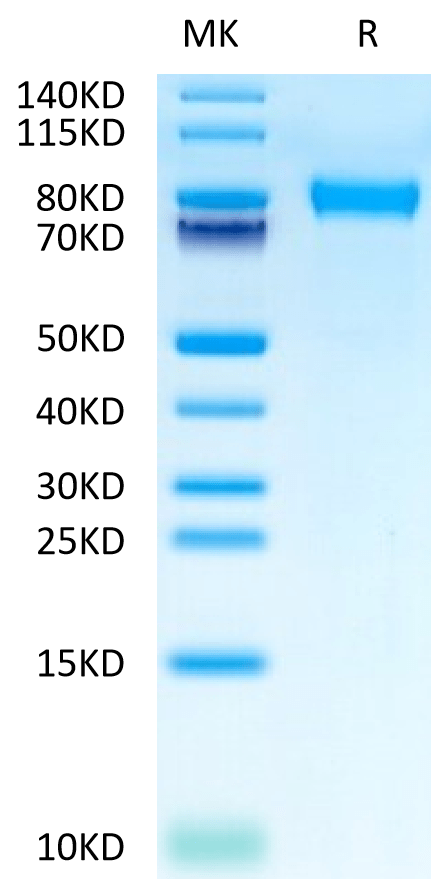| Weight | 1 lbs |
|---|---|
| Dimensions | 9 × 5 × 2 in |
| accession | P05532 |
| express system | HEK293 |
| product tag | C-His |
| purity | > 95% as determined by Tris-Bis PAGE;> 95% as determined by HPLC |
| background | The c-kit proto-oncogen (CD 117) has been shown to be present in several cell types including normal and neoplastic hemopoietic cells. Among normal BM cells, CD117 expression has been found in about half of the CD34 precursors including progenitors committed to the erythroid, granulo-monocytic, and megakaryocytic cell lineages. |
| molecular weight | The protein has a predicted MW of 56.63 kDa. Due to glycosylation, the protein migrates to 75-100 kDa based on Tris-Bis PAGE result. |
| available size | 100 µg, 500 µg |
| endotoxin | Less than 1EU per μg by the LAL method. |
Mouse CD117 Protein 2572
$1,050.00
Summary
- Expression: HEK293
- Binding assay: Yes (SPR)
- Amino Acid Range: Ser25-Pro523
Mouse CD117 Protein 2572
| protein |
|---|
| Size and concentration 100, 500µg and lyophilized |
| Form Lyophilized |
| Storage Instructions Valid for 12 months from date of receipt when stored at -80°C. Recommend to aliquot the protein into smaller quantities for optimal storage. Please minimize freeze-thaw cycles. |
| Storage buffer Shipped at ambient temperature. |
| Purity > 95% as determined by Tris-Bis PAGE |
| target relevance |
|---|
| The c-kit proto-oncogen (CD 117) has been shown to be present in several cell types including normal and neoplastic hemopoietic cells. Among normal BM cells, CD117 expression has been found in about half of the CD34 precursors including progenitors committed to the erythroid, granulo-monocytic, and megakaryocytic cell lineages. |
| Protein names Mast/stem cell growth factor receptor Kit (SCFR) (EC 2.7.10.1) (Proto-oncogene c-Kit) (Tyrosine-protein kinase Kit) (CD antigen CD117) |
| Gene names Kit,Kit Sl |
| Protein family Protein kinase superfamily, Tyr protein kinase family, CSF-1/PDGF receptor subfamil |
| Mass 10090Da |
| Function Tyrosine-protein kinase that acts as a cell-surface receptor for the cytokine KITLG/SCF and plays an essential role in the regulation of cell survival and proliferation, hematopoiesis, stem cell maintenance, gametogenesis, mast cell development, migration and function, and in melanogenesis. In response to KITLG/SCF binding, KIT can activate several signaling pathways. Phosphorylates PIK3R1, PLCG1, SH2B2/APS and CBL. Activates the AKT1 signaling pathway by phosphorylation of PIK3R1, the regulatory subunit of phosphatidylinositol 3-kinase. Activated KIT also transmits signals via GRB2 and activation of RAS, RAF1 and the MAP kinases MAPK1/ERK2 and/or MAPK3/ERK1. Promotes activation of STAT family members STAT1, STAT3, STAT5A and STAT5B. Activation of PLCG1 leads to the production of the cellular signaling molecules diacylglycerol and inositol 1,4,5-trisphosphate. KIT signaling is modulated by protein phosphatases, and by rapid internalization and degradation of the receptor. Activated KIT promotes phosphorylation of the protein phosphatases PTPN6/SHP-1 and PTPRU, and of the transcription factors STAT1, STAT3, STAT5A and STAT5B. Promotes phosphorylation of PIK3R1, CBL, CRK (isoform Crk-II), LYN, MAPK1/ERK2 and/or MAPK3/ERK1, PLCG1, SRC and SHC1. |
| Catalytic activity #N/A |
| Subellular location [Isoform 1]: Cell membrane; Single-pass type I membrane protein.; [Isoform 2]: Cell membrane; Single-pass type I membrane protein.; [Isoform 3]: Cytoplasm. Note=Detected in the cytoplasm of spermatozoa, especially in the equatorial and subacrosomal region of the sperm head. |
| Tissues Isoform 1 and isoform 2 are detected in bone marrow cells, spermatogonia and spermatocytes, but not in round spermatids, elongating spermatids and spermatozoa. Isoform 3 is detected in round spermatids, elongating spermatids and spermatozoa, but not in spermatogonia and spermatocytes (at protein level). Isoform 1 is widely expressed and detected in fetal liver and bone marrow. Isoform 3 is detected in bone marrow cells enriched in hematopoietic stem cells. |
| Structure Monomer in the absence of bound KITLG/SCF. Homodimer in the presence of bound KITLG/SCF, forming a heterotetramer with two KITLG/SCF molecules. Interacts (via phosphorylated tyrosine residues) with the adapter proteins GRB2 and GRB7 (via SH2 domain), and SH2B2/APS. Interacts (via C-terminus) with MPDZ (via the tenth PDZ domain). Interacts (via phosphorylated tyrosine residues) with the protein phosphatases PTPN6/SHP-1 (via SH2 domain), PTPN11/SHP-2 (via SH2 domain) and PTPRU. Interacts with DOK1 and TEC (By similarity). Interacts with the protein kinase FES/FPS. Interacts with PLCG1. Interacts (via phosphorylated tyrosine residues) with PIK3R1 and PIK3 catalytic subunit. Interacts (KITLG/SCF-bound) with IL1RL1. Interacts with IL1RAP (independent of stimulation with KITLG/SCF). A mast cell-specific KITLG/SCF-induced interleukin-33 signaling complex contains IL1RL1, IL1RAP, KIT and MYD88. |
| Post-translational modification Ubiquitinated by SOCS6. KIT is rapidly ubiquitinated after autophosphorylation induced by KITLG/SCF binding, leading to internalization and degradation (By similarity).; Autophosphorylated on tyrosine residues. KITLG/SCF binding promotes autophosphorylation of isoform 1 and isoform 2. Isoform 1 shows low levels of tyrosine phosphorylation in the absence of added KITLG/SCF, while isoform 2 requires stimulation by KITLG/SCF for phosphorylation (in vitro). Phosphorylation of Tyr-573 is required for interaction with PTPN6/SHP-1. Phosphorylation of Tyr-571 is required for interaction with PTPN11/SHP-2. Phosphorylated tyrosine residues are important for interaction with specific binding partners. |
| Target Relevance information above includes information from UniProt accession: P05532 |
| The UniProt Consortium |
Data
Publications
Publications
| pmid | title | authors | citation |
|---|---|---|---|
| We haven't added any publications to our database yet. | |||
Protocols
| relevant to this product |
|---|
Documents
| # | ||
|---|---|---|
| Please enter your product and batch number here to retrieve product datasheet, SDS, and QC information. | ||

















